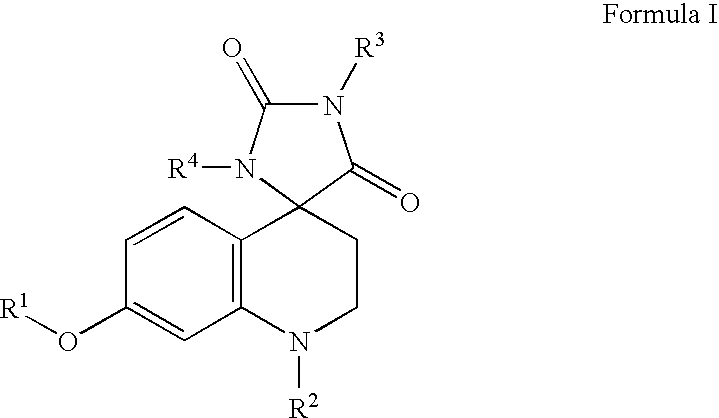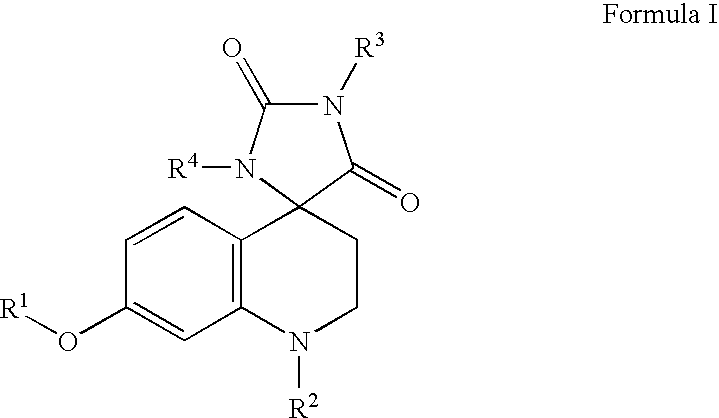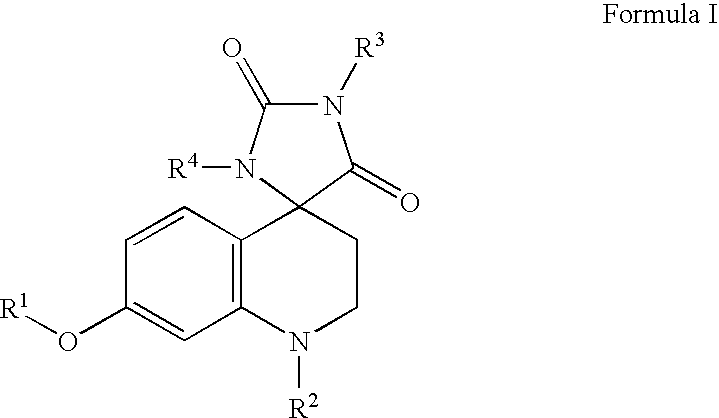Somatostatin analogue compounds
a technology of somatostatin and analogue compounds, applied in the field of pharmaceuticals, can solve the problems of undesirable pharmacologic characteristics, peptide compounds are generally more expensive to manufacture than organic molecules, and the inherent disadvantage of having a peptide structur
- Summary
- Abstract
- Description
- Claims
- Application Information
AI Technical Summary
Benefits of technology
Problems solved by technology
Method used
Image
Examples
example 1
Preparation of 4-Phenoxyaniline-3′-bromopropionamide
1A: Preparation of Compound 1, where R1 is phenyl.
A well stirred solution of 3-phenoxyaniline (1.85 g, 10 mmol) in 20 mL of dichloromethane (DCM) was treated successively with 3-bromopropionic acid (1.74 g, 11 mmol), 1-(3-dimethylaminopropyl)-3-ethylcarbodiimide HCl (EDC) (2.35 g, 12 mmol) and 4-dimethylaminopyridine (0.06 g, 0.5 mmol), under an atmosphere of dry nitrogen. The resulting solution was allowed to stir for 30 min. at room temperature. The mixture was then poured into 150 mL of chloroform and washed successively with 50 mL 1 N HCl, 50 mL water, sat. aqueous NaHCO3 (2×50 mL), 50 mL brine then dried (Na2SO4) and evaporated. This oil (2.4 g, 100% crude yield) was used directly in the next steps.
example 2
Preparation of 4-Benzyloxyaniline-3′-bromopropionamide
2A: Preparation of Compound 1, where R1 is benzyl.
A well stirred solution of 3-benzyloxyaniline (5.08 g, 25 mmol) in 40 mL of DCM was treated successively with 3-bromopropionic acid (4.34 g, 27.5 mmol), 1-(3-dimethylaminopropyl)-3-ethyl-carbodiimide HCl (EDC) (5.61 g, 28.7 mmol) and 4-dimethylaminopyridine (0.305 g, 2.5 mmol), under an atmosphere of dry nitrogen. The resulting solution was allowed to stir for 30 min. at room temperature. The mixture was then poured into 150 mL of chloroform and washed successively with 50 mL 1 N HCl, 50 mL water, sat. aqueous NaHCO3 (2×50 mL), 50 mL brine then dried (Na2SO4), filtered though a pad of silica gel and the filtrate evaporated. This oil (8 g, 96% yield) was used directly in the next steps. 1H NMR (CDCl3) δ 2.93 (t, 2H), 3.71 (t, 2H), 5.07 (s, 2H), 6.7-7.5 (m, 9H).
example 3
Preparation of 1-(3-Benzyloxy-phenyl)-azetidin-2-one
3A: Compound 2, where R1 is benzyl.
A well stirred solution of Compound 1 (where R1 is benzyl) prepared as above and used directly (8.35 g, 25 mmol) in 150 mL of DCM was treated successively with KOH (1.4 g, 25 mmol), and tetrabutylammonium bromide (8.06 g, 25 mmol) under an atmosphere of dry nitrogen. The resulting solution was allowed to stir for 3 h at room temperature. The mixture was then poured into 150 mL of DCM and washed successively 50 mL water, sat. aqueous NH4Cl (2×50 mL) and 50 mL brine then dried (Na2SO4) and evaporated. This residue was then purified by column chromatography (methanol / DCM 1 / 300) to give 4.5 g (74%) of pure material. M.p.=96-98° C. 1H NMR (CDCl3) δ 2.93 (t, 2H), 3.71 (t, 2H), 5.07 (s, 2H), 6.7-7.5 (m, 9H). Cald. for C16H15NO2; C, 75.87%, N, 5.53%, H, 5.97%; Found: C, 75.60%, H, 5.97%, N, 5.48%.
PUM
| Property | Measurement | Unit |
|---|---|---|
| peptide structure | aaaaa | aaaaa |
| solubility | aaaaa | aaaaa |
Abstract
Description
Claims
Application Information
 Login to View More
Login to View More - R&D
- Intellectual Property
- Life Sciences
- Materials
- Tech Scout
- Unparalleled Data Quality
- Higher Quality Content
- 60% Fewer Hallucinations
Browse by: Latest US Patents, China's latest patents, Technical Efficacy Thesaurus, Application Domain, Technology Topic, Popular Technical Reports.
© 2025 PatSnap. All rights reserved.Legal|Privacy policy|Modern Slavery Act Transparency Statement|Sitemap|About US| Contact US: help@patsnap.com



